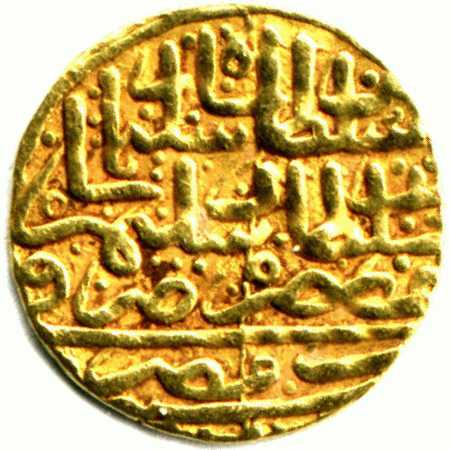| SPECIFICATIONS | |
| Denomination | Sultani |
| Metal XRF | Gold Au0.990 |
| Alloy | Ag%Cu 0.90 |
| Type | Struck |
| Diameter | 18.6 mm |
| Thickness | 1.1 mm |
| Weight Legal | 3.50 gms |
| Weight | 3.44 gms |
| Shape | Round |
| Edge | Plain |
| Die Axis | 180° |
| Mint | Misr |


|

| 
| ||||||||||||||||||||||||||
| N. Pere No. 180; Album 1317 | ||||||||||||||||||||||||||||
Ceylon Coins and Currency By Codrington records 11 Othmanli coins of
Süleyman the Magnificent found in Lanka with mint distribution:
Constantinople .. 3; Cairo .. 3; Brusa .. 1; Damascus .. 1; Sidrekapusu .. 2;
and ?Seres .. 1.
Sultani shown on this page is not from circulation in Lanka.
Slobodan Sreckovic of Belgrade an author who has studied the die variation
of Ottoman coins in
Reply
to my posting on Islamic Coins Group said Is a rare variant,
struck on the very beginning of Süleyman I rule.
Steve Album said The calligraphic arrangement of the reverse
inscription is somewhat unusual, probably rather rare, The date is off
flan, but by style I strongly suspect that it is 926 Hijri, not as the
actual year, but as the accessional year, which was used on Misr coins
struck from abour AH943 until the end of Süleyman's reign in
AH974. Süleyman gold sultanis struck at Misr (=Cairo), are
Abundant. Even if the variant were truly rare, I doubt it would have
a premium value to any collector.
The Ottoman sultan Süleyman the Magnificient (1520-1566), was son and successor of Selim I. He is sometimes erroneously called Sulayman II. Under him the Ottoman Empire reached the height of its power and prestige. Süleyman died during the siege of Szigetvar. His death was concealed from his army for 7 weeks and fought on unknowingly.
The later years of Süleyman's reign had been marred by family disputes over the succession. His favorite wife, Roxelana (or Khurema) intrigued against his eldest son, Mustafa, on behalf of her two sons, Selim and Beyazid. Mustafa built up his own faction, which seemed a threat to Süleyman. In 1553, Süleyman had him executed. Upon Roxelana's death, Selim and Beyazid quarreled. Beyazid rose in revolt, met defeat, and fled to Persia. The shah of Persia was induced to return him for a large sum, and Beyazid was executed. Selim succeeded Süleyman as Selim II.
In his government Süleyman was distinguished for his justice. His military, educational, and legal reforms earned him the name Süleyman the Lawgiver among Muslims. He was fond of pomp and splendor and was a lavish patron of the arts and of literature. Sinan, the greatest Ottoman architect, worked under his orders
Text edited from Internet and The Ever Victorious - Guide to Ottoman Empire Numismatics 1971 by Jem Sultan
The coin was scanned at 600 dpi and displayed at 300 dpi. It was won on ebay in Oct 1999 from a Canadian seller from whom I also purchased the Murad III sultani.